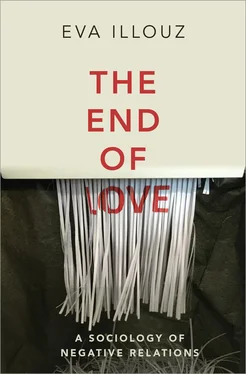The social effects of negative choice are apparent in many significant ways. One is the fact that many countries cannot maintain their populations in terms of their birth rates. Young Japanese, for example, have tremendous difficulties “in pairing up,” with the result that “the fertility rate has plunged. The number of children a Japanese woman can expect to have in her lifetime is now 1.42, down from 2.13 in 1970.” 51Negative population growth rates are observed in Eastern and much of Western Europe as well, and they are threatening not only demography but economy as well. The shrinkage of the population has powerful rippling political and economic effects, from immigration flows to the difficulty of guaranteeing pension funds or supporting aging populations. If the expansion of capitalism was predicated on population growth and on the family as the structure mediating between economy and society, that connection is increasingly being undone by the new forms of capitalism themselves. Capitalism is a formidable machine to produce goods but is no longer capable of ensuring the social need for reproduction, what philosopher Nancy Fraser has called capitalism “crisis of care.” 52Negative relations are apparent in the conscious decision or non-conscious practices by many men and women not to enter stable bonds or have children and in the fact that single households have considerably increased in the last two decades. 53A second way in which negative choice is made apparent is by the development of divorce rates. In the United States, for example, the rate more than doubled between 1960 and 1980. 54In 2014 it was more than 45 percent for people who married in the 1970s or in the 1980s, 55making divorce a likely occurrence in a large portion of the population. Third, more people live in multiple relationships (of the polyamorous or other types), putting into question the centrality of monogamy and attendant values as loyalty and long-term commitment. An increasing number of people leave and enter, enter and leave a larger number of relationships in a fluid way throughout their lives. A fourth, seemingly opposite, manifestation of non-choice is sologamy, the puzzling phenomenon of (mostly) women who choose to marry themselves, 56thereby declaring their self-love and affirming the worth of singlehood. Finally, negative choice is somehow implicated in what a commentator has called the “loneliness epidemic”: “An estimated 42.6 million Americans over the age of 45 suffer from chronic loneliness, which significantly raises their risk for premature death, according to a study by AARP (American Association of Retired Persons). 57One researcher called 58the loneliness epidemic 59“a greater health threat than obesity.” 60The loneliness epidemic has another form. As Jean Twenge (a psychology professor at San Diego State University) has suggested, members of the iGen generation (the generation after the millennials) have fewer sex partners than members of the two preceding generations, making the lack of sexuality a new social phenomenon, explained I would argue, by the cultural shift to negative choice, to the quick withdrawal from relationships or to the fact that relationships themselves never get formed. 61
In the realm of intimate relationships, choice is exerted in a context that is very different from the one of Pierre Bezukhov, in which choice often took place between two clear alternative paths. Under the massive influence of new technological platforms, freedom creates now such a large number of possibilities that the emotional and cognitive conditions for romantic choice have been radically transformed. Whence the question addressed here: what are the cultural and emotional mechanisms, voluntary and involuntary, that make people revise, undo, reject, and avoid relationships? What is the emotional dynamic by which a preference changes (leaving a relationship one was engaged in)? Although many or most live in some satisfactory form of couplehood (or temporary sexual and emotional arrangement), this book is about the arduous path of many to reach that point as well as with the fact that many, by choice or non-choice, do not live in a stable relationship. This book is not an indictment of the ideal of couplehood or a plea to return to more secure ways of forming it, but rather a description of the ways in which capitalism has hijacked sexual freedom and is implicated in the reasons why sexual and romantic relationships have become puzzlingly volatile.
Much of sociology has been about the study of the regular, routine structures of daily life and has developed to that effect an impressive array of methods. But the contemporary era commands perhaps another type of sociology, which I would tentatively call the study of crisis and uncertainty. The orderliness and predictability of modern institutions have been disrupted for large swaths of the population; routine and bureaucratic structures coexist with a pervasive and nagging sense of uncertainty and insecurity. If we can no longer count on lifelong employment, on the returns of increasingly volatile markets, on the stability of marriage, on geographical stability, then many traditional sociological concepts have served their time. It is high time that we listen to the practitioners of the new culture of unloving, and therefore I conducted interviews with ninety-two people in France, England, Germany, Israel, and the United States from the age of nineteen to the age of seventytwo. 62Their stories form the empirical backbone of the book—and they all bear the traces of what Lauren Berlant calls the “crisis of ordinariness,” that is, the low-key ways in which actors, located in different cultural contexts and socioeconomic positions, struggle with the minute dramas of precariousness and uncertainty, 63with the properties of what I call negative relationships. Negative relationships obviously take different forms in different social classes and different national frameworks, but they contain a few recurring elements: they enact economic and technological features; they do not gel in a stable social form but are valued as ephemeral and transitory; and they are practiced even when that entails loss and pain. Whether these two processes produce pleasure or pain, they constitute, as we will see, unloving , whereby the prefix “un-” expresses both the willful undoing of something established (as in “untying” the knot), and the inability to achieve something (as in “unable”). One form of unloving necessarily precedes loving (e.g., the one-night stand) and another follows it (the divorce). Both cases enable us to understand the conditions of emotions and relationships in the era of radical personal freedom. It is this condition I decipher in this book.
1 1. George Orwell, “In Front of Your Nose,” The Collected Essays, Journalism and Letters of George Orwell (1946; New York: Harcourt, Brace & World, 1968).
2 2. For extensive discussion on Plato’s theory of forms, see Russell M. Dancy, Plato’s Introduction of Forms (Cambridge: Cambridge University Press, 2004); Gail Fine, Plato on Knowledge and Forms: Selected Essays (Oxford: Oxford University Press, 2003).
3 3. This paragraph is taken from my article on unloving, “The Thrill Is Gone: Why Do We Fall Out of Love?” Haaretz, September 7, 2013, https://www.haaretz.com/.premium-why-do-we-fall-out-of-love-1.5329206, accessed February 13, 2018.
4 4. Émile Durkheim, Suicide: A Study in Sociology, trans. John A. Spaulding and George Simpson (1897; New York: Simon & Schuster, 1997).
5 5. Wendell Bell, “Anomie, Social Isolation, and the Class Structure,” Sociometry 20, no. 2 (1957): 105–116; Émile Durkheim, 1997 [1897]. Suicide: A Study in Sociology, trans. John A. Spaulding and George Simpson (1897; New York: Simon & Schuster, 1997); Claude S. Fischer, “On Uban Alienations and Anomie: Powerlessness and Social Isolation,” American Sociological Review 38, no. 3 (1973): 311–326; Robert D. Putnam, Bowling Alone: The Collapse and Revival of American Community (New York: Simon & Schuster, 2001); Frank Louis Rusciano, “‘Surfing Alone’: The Relationships among Internet Communities, Public Opinion, Anomie, and Civic Participation,” Studies in Sociology of Science 5, no. 3 (2014): 1–8; Melvin Seeman, “On the Meaning of Alienation,” American Sociological Review 24, no. 6 (1959), 783–791; Bryan Turner, “Social Capital, Inequality and Health: The Durkheimian Revival,” Social Theory and Health 1, no. 1 (2003): 4–20.
Читать дальше












